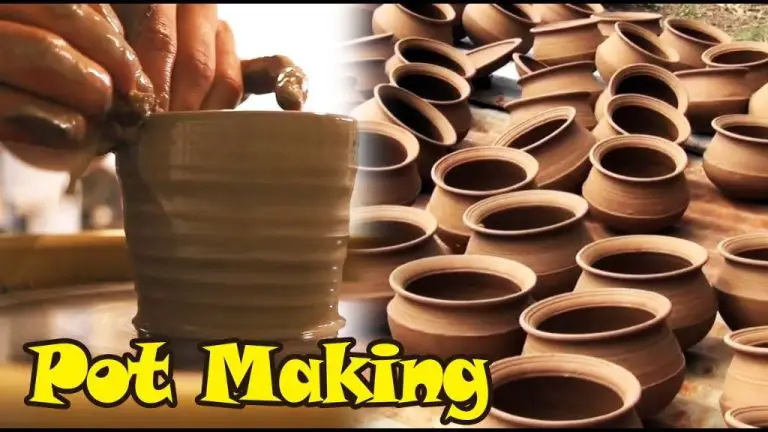Are Clay Pipes Still Made?
Clay pipes have a long history dating back to the 16th century when they became popular for smoking tobacco. They were originally made using clay for the pipe bowl and stem, which allowed smokers to easily dispose of them when finished.
These early tobacco pipes were produced in large quantities and used throughout Europe and the American colonies during the 1600s and 1700s. They were an inexpensive and convenient option before the common use of cigarettes and reusable smoking pipes.
The popularity of clay pipes declined by the late 1800s with the introduction of briar pipes and cigarettes. Briar pipes offered a more premium smoking experience, while cigarettes were quicker and easier for smoking on-the-go. Although clay pipes are no longer widely used for smoking today, they still hold historical and cultural significance.
Manufacturing Process
Clay pipes are traditionally made through a multi-step process that involves meticulous molding and firing techniques. The process begins with a clay mixture called “pipe clay” that contains the right balance of minerals to prevent cracking and over-firing. Pipe clay is rolled into long cylinders and then molded around a “pipe former” which imprints the hollow airway down the center of the pipe shaft. Once molded, artisans use specialized tools to sculpt decorative shapes and patterns into the bowls and stems. The unfinished pipes are set aside to air dry for several weeks before the first firing, which hardens them enough for the artisans to apply glazes and decorative colors. Finally, the pipes undergo a high-temperature firing which can reach over 2,000°F. The firing fuses the minerals and transforms the soft clay into a durable, hardened ceramic material. Firing techniques are closely guarded secrets among pipe makers, as small variations in temperature and timing can drastically impact the final product. Overall, traditional clay pipe creation involves significant skill, artistry, and patience at every stage from molding to firing.
Current Manufacturers
While clay pipe manufacturing has significantly declined over the past century, there are still a handful of companies that continue the historic tradition on a small scale.
Some of the remaining clay pipe producers include Gouda Pipe Factory in the Netherlands, Missouri Meerschaum in Washington, Missouri, and Butz Choquin in France. These companies maintain production primarily as a legacy business, focusing on artisanal craftsmanship and specialty pipes.
Gouda Pipe Factory was founded in 1869 and produces ornately decorated porcelain pipes. They offer factory tours and have a small on-site museum. Missouri Meerschaum began in 1869 as well, and is known for making affordable corn cob and clay pipes. Butz Choquin dates back to 1780 and continues handcrafting briar tobacco pipes alongside a small number of clay pipes.
While quite small in scale today, these historic companies preserve the tradition of clay pipe making. They focus more on artistry and craft, rather than large-scale manufacturing. Their customer base tends to be pipe collectors and aficionados, rather than the general public.
Modern Uses
While clay pipes are no longer as commonly used for smoking tobacco as they once were, they still have a number of modern uses, particularly for artistic, decorative, and ceremonial purposes. Many clay pipe makers today cater to collectors and gift shops, producing finely crafted clay pipes that serve mainly as decorative objects rather than functional smoking pipes.
Clay pipes have become popular niche collector’s items, with entire books dedicated to documenting the history and artistry of pipe making. Collectors may focus on pipes from a certain region, time period, or pipe maker. Antique shops frequently carry selections of old clay pipes.
In films, TV shows, and plays set in earlier time periods, clay pipes are commonly used as props to add authenticity. For example, an actor playing a Victorian-era Sherlock Holmes would likely be depicted smoking a clay pipe. Theaters may use inexpensive replica clay pipes as disposable props. Some companies even specialize in creating replica pipes for prop houses.
Overall, while clay pipes are no longer as ubiquitous as they once were, they still hold cultural significance and special appeal for collectors and artists keeping old pipe-making traditions alive.
Decline of Popularity
Clay pipes were once the most common way for people to smoke tobacco, but their popularity began to decline in the late 19th and early 20th centuries with the advent of other materials like briar and metals. Several factors contributed to this decline:
The introduction of briar pipes in the mid-1800s provided smokers with a more durable and versatile alternative to clay. Briar pipes were seen as more sophisticated and expensive than humble clay pipes. Around the same time, meerschaum pipes, made from a mineral called sepiolite, also became popular. Meerschaum was valued for its porous qualities that provided a cool, dry smoke.
By the early 1900s, cigarettes and cigars were overtaking pipes as the most popular way to smoke tobacco. Cigarettes were quicker and easier to smoke than pipes. As pipe smoking became less common, the market for inexpensive clay pipes shrank.
New laws and cultural attitudes around smoking changed in the 20th century. Regulations limited public smoking, while health concerns caused many to cut back or quit smoking altogether. This further contributed to the decline of clay pipe use.
While still made by some manufacturers today, clay tobacco pipes are now considered collectibles rather than everyday smoking implements. Their peak popularity has passed, but they still hold nostalgia and cultural significance.
Collector’s Market
Vintage clay pipes have become highly collectible over the years. There is an active community of antique pipe collectors and enthusiasts who seek out rare and unique clay pipes from the 17th-19th centuries.
The rarity and age of a pipe often determines its value to collectors. Intricately carved pipes made by renowned pipemakers can fetch high prices at auction. Common mass-produced pipes tend to be less valuable, while one-of-a-kind artisan pipes can sell for thousands of dollars.
The material, style, maker’s mark, and condition factor into a pipe’s desirability. Highly decorated pipes depicting historic events, figures, or scenes are more prized. Pipes that are completely intact and unbroken also command premium prices.
Clay pipe collecting has grown as a hobby since the 1960s. Collector clubs, magazines, books, and online communities exist to discuss and trade these historical artifacts of smoking culture.
Cultural Significance
Clay pipes have played an important role in early American and European culture. They were one of the most common objects found at 17th- and 18th-century archaeological sites in Europe and the English colonies of North America.
The form of clay pipes changed over time, and archaeologists use these changes to help date sites and archaeological layers. The size of the bowl and the bore, or hole from the bowl to the stem, provides clues about when the pipe was made. The stems became longer and the bowls smaller as tobacco became cheaper and more readily available.
Decorated pipes with motifs like flowers or portraits reveal information about aesthetics and popular imagery during different periods. Makers often signed their work, allowing archaeologists to trace pipes back to their origins and study trade.
The ubiquity of locally-made clay pipes at archaeological sites shows their importance in early modern material culture. Scholars have studied them to learn about smoking, trade networks, class differences, and other cultural trends.
Notable Pipemakers
Clay tobacco pipes have been made for centuries by skilled artisans across Europe and America. Some of the most famous early pipemaking came from England and Scotland.
The English town of Broseley in Shropshire was an important early hub for pipemaking starting in the 1600s, home to famous companies like the Benthall works. The Scottish capital of Edinburgh also became renowned for its finely crafted clay pipes in the 1700s under makers like David Munro and his son Alexander.
In the United States, early pipemaking centers emerged in cities like New York and Philadelphia in the 1800s. Companies like Henderson and Salterini created sought-after clay pipes that were shipped around the country.
While factories eventually overtook individual pipemakers in scale, some of the original pipemaking towns maintain a legacy of quality craftsmanship passed down through generations of artisans.
The Future
Though clay pipemaking was once a booming industry, it is unlikely to see a major resurgence. The decline in popularity of pipe smoking along with the rise of mass production using alternative materials has severely reduced demand for traditional clay pipes.
Nonetheless, clay pipes retain an appeal among niche markets like historical reenactors, some pipe collectors, and smoking pipe enthusiasts looking for a classic experience. Small-scale artisanal pipemakers able to tap into these niche markets are likely to persist.
Additionally, clay pipes hold sentimental value for history lovers and those wanting to celebrate local cultural heritage. Even as large-scale clay pipe production fades, the legacy of iconic pipemaking towns and artisans is sure to be preserved by historians and museum curators.
While a clay pipe renaissance seems improbable, the rich history and traditional charm ensures clay pipes will continue capturing the imagination of the niche markets and history aficionados keeping the old craft alive.
Conclusion
While clay pipes are no longer as popular as they once were, they played an important role through much of history. Clay pipes were the predominant way to smoke tobacco beginning in the 16th century through the early 20th century. Their heyday was during the Victorian era of the 19th century, when clay pipemaking was a thriving industry and culturally significant folk art form.
Today, interest in clay pipes remains among collectors and those who appreciate their craftsmanship. Though not as commonly used, some pipe makers continue the tradition of creating high quality clay pipes. The legacy of clay pipes lives on through their continued use by pipe enthusiasts and presence in museums and private collections. Their history provides a window into smoking culture and decorative arts through the centuries.




